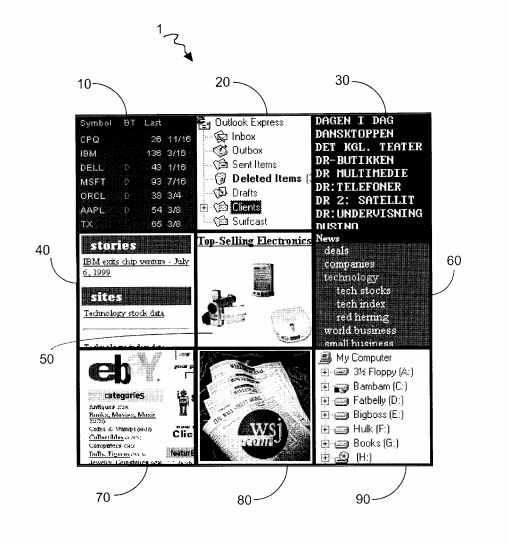Windows 8, Windows Phone live tile interface called a copycat in patent infringement suit

In the district court of Maine yesterday, a small, privately owned company called Surfcast Inc. filed a patent infringement complaint against Microsoft for its famous live tile interface, now common among both the Windows and Windows Phone operating system families.
Surfcast was granted a patent back in 2004 (#6,724,403) for a "System and Method For Simultaneous Display of Multiple Information Sources," which bears a strong resemblance to Microsoft's live tile interface.
Surfcast's interface, like Microsoft's Live Tile interface, was conceived as a cross-platform UI, but it was designed as a method of prioritizing information feeds. The patent summary describes the interface as "an array of tiles in a non-overlapping configuration, assigning a first refresh rate to a first tile of said array of tiles, and a second refresh rate to a second array of tiles…"
The image at the head of the story contains the following legend:
Figure 1 shows an illustrative configuration of the graphical user interface of the present invention. A grid 1 consists of a 3 x 3 matrix of nine tiles demonstrates some of the different contents that tiles can display. Tile 10 points to a database of stock quotes. Tile 20 displays the active folders in an electronic mail utility. Tile 30 displays a portion of an alphabetical list of quoted companies. Tiles 40,50,60,70, and 80 point to websites displaying, respectively, high technology news, electronic goods for sale, categories of business news, items available by auction, and the Wall Street Journal. Tile 90 points to the file-viewer of a windows-based operating system and displays the currently accessible disc drives.
The tiles, Surfcast's patent says, could contain video, audio, text and graphics in any format, including but not limited to ASCII, bitmap, MP3, JPEG, GIF, TIFF, markup languages like HTML, XML, VRML, HDML, or formatted text like RTF or binary.

A significant portion of the patent lays out very clearly what its concept of tiles entails, and how they were different from existing UIs at the time: "A tile is different from an icon because it provides a real-time or near-real time view of the underlying information in that it contains continually refreshed content. A tile is different from a window because a tile will typically be smaller in size, allowing the user to view multiple tiles simultaneously if desired. A tile provides an at-a-glance view of the current status of the program or file associated with it but does not necessarily have the large number of active areas associated with windows such as a tile bar, menu bar, and scroll bars. Therefore tiles lead to a reduction in clutter on the display screen because many tiles may be displayed simultaneously without overlapping with one another in a way that windows must necessarily do."
In its complaint, Surfcast Inc. accuses Microsoft of both contributory infringement and willful direct infringement of this patent in all of its operating systems that contain the tile interface, and it seeks damages.